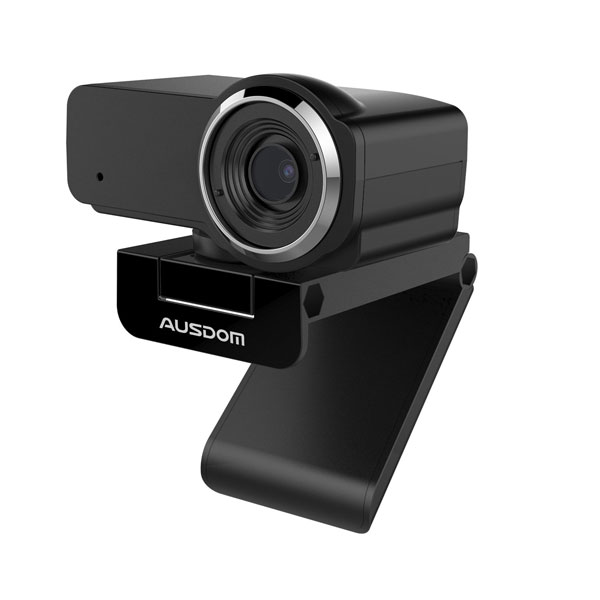Why You Should Consider Using an External Webcam
In a world where remote meetings and classes are the new norm, an external webcam can offer a clear step up from your built-in camera.

Editor’s note: The links on this page to Amazon include our affiliate code, which helps support CreativePro.
Once upon a time, not very long ago, if you wanted to shoot live video into your computer, you needed to attach an external video camera. Now, of course, virtually every computer and mobile device includes at least one built-in webcam. So, for most of us, external webcams went from necessity to novelty, something to be attached to a pet, a helmet, or a drone.
And then COVID lockdowns arrived. Those of us lucky enough to be able to operate remotely became completely dependent on those webcams for work, school, and socializing with family and friends.
We live in San Francisco, the first city to mandate lockdowns and masks for COVID. San Francisco State University (SFSU), where Jeff is a Professor, was the first U.S. university to go fully virtual last spring. Jeff teaches sound, radio, and live-event production in the Broadcast department of SFSU. They’re the department that “puts on shows”—so needless to say, he’s a performative teacher. When he’s teaching he’s moving around the class, and even when he’s at a podium, he’s standing. So, second only to the heartbreak of not getting to be in person with his students, was the pain of being forced to sit at his computer to conduct his classes. Then we were offered the opportunity to review a new webcam. Here are Jeff’s thoughts about it.
First Impressions
I was delighted to receive a delivery of the AUSDOM 1080P Webcam (Model AW635). The list price of this camera is $99, but right now Amazon is offering it for $39. The box contained the fully assembled camera and an instruction booklet.

The AUSDOM AW635 USB Streaming Web Camera Full HD 1080p Webcam with Auto Low-light Correction
Like most people, I just want the thing to work right out of the box without even glancing at the instructions, and it does say that it’s “plug & play” so I went for it. First, however, I needed to figure out the clamp thing that attaches the camera to my laptop. It swivels, but it doesn’t actually clamp. It sort of rests on the edge of the computer monitor with a low confidence-building scissor-like non-clamp. If you move your computer or adjust the screen, it may fall off. But after repeated use, it seemed to be stable enough.
Image Quality
With the USB connector attached and the camera perched in place, I started a Zoom session with video. The first thing I noticed was that the image was not as wide-angle as the Mac laptop built-in camera. All things are relative, but the Mac camera’s framing is much wider than the AUSDOM AW635. That isn’t a deal breaker—whether it’s good or bad just depends on what you want. I also noticed that in low-light settings (my first test), the AUSDOM appeared less clear, without any noticable ability to adjust for lighting color (AKA: lighting temperature).
I also fiddled around with the camera and found that I could adjust the focus manually with the focus ring (a little hard to access), but I’m not sure why you would want that for a Zoom session or similar use. I’m not making a feature film here, just chatting online, and using auto-focus is easier under those circumstances.
Camera Software
Next, it was time to download and test the accompanying software. I went to the website (ausdom.com), clicked on the link for webcams, downloaded the software, and hit a wall. It simply doesn’t work on a Mac. The manual clearly indicates it should work, but it doesn’t. I contacted the manufacturer, and they suggesting using Camtwist, an app that can be downloaded for free. So I did that. The app gives you some fun tricks and effects, but doesn’t do much else. I can’t comment on how well the AUSDOM software works on Windows, but you can check out the features (basic audio and video settings) in the user manual.
Sound Quality
The built-in microphone works about the same as a computer mic, but because you are likely to use this camera from farther away, it sounds pretty terrible. You simply can’t be 5 or 6 feet away from a microphone and still sound good no matter the quality of your mic, and this one isn’t high quality. I found the best method was to go to my Zoom settings and use the visuals from the camera and my computer microphone for the sound. Of course, if you have the technology and the know-how, you can also use a better-sounding and better-placed lavalier mic.
Using a TV as a Monitor

The AUSDOM webcam attached to a TV
I also tried using my big-screen TV as the monitor and attached the camera to the top of the screen, stood about four feet away, and started a Zoom session. The camera showed about the right amount of me and the background, and if the lighting was reasonably good the image was noticeably better than the built-in Mac camera. It was warmer and a bit sharper. By placing my laptop right where I was standing, I could use the computer mic in this setup, and that worked quite well. Unfortunately, there didn’t seem to be any setting for: “make me look good on camera so I don’t hate myself.” Oh, well, maybe someday.
The Final Word
Having an external camera does provide some options for camera placement—which is a good thing—and the attached cable is just long enough. But I would hope that for a $99 list price, you would get a noticeable improvement in low-light situations and a better microphone. For the sake of privacy, I also want a way to close or cover the camera lens (a lens cap, perhaps?) when not in use. I just unplugged the HDMI cable instead, an inelegant but highly effective solution.
While not a massive improvement in my online life, the AUSDOM AW635 1080P Webcam is a definite step up from my computer’s built in camera, especially when attached to a big-screen TV. I am already defaulting to using it for teaching my online classes, and I can happily recommend it for this sort of use.

Jeff Jacoby teaching class remotely with the aid of AUSDOM AW635 webcam.
This article was last modified on September 20, 2021
This article was first published on September 13, 2021



